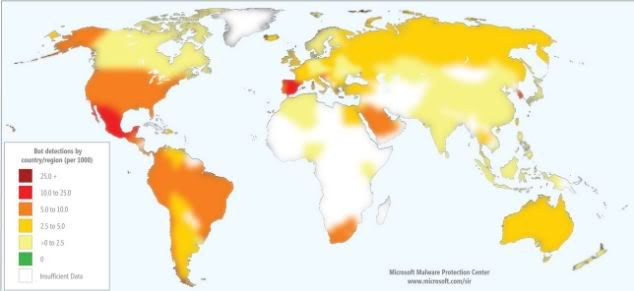The firm discovered that the US leads the world in numbers of Windows PCs that are part of botnets and that Spain has the most infected machines in Europe.
Between April 2010 and June 2010, Microsoft cleaned more than 6.5 million computers of botnet infections — double the amount for the same period a year before.

Botnets start when a virus infects a computer, often through spam emails. The infected machine is then placed under the control of an external hacker, often without the user’s knowledge
Adrienne Hall, general manager, Microsoft Trustworthy Computing told a cybercrime conference that botnets allow criminals to perpetrate spam, phishing, fraud and identity theft.
‘We’ve known for years that an online black market exists and that cybercrime specialists trade with each other,’ Hall said.
Cliff Evans, Head of Microsoft Security UK said: 'The Security Intelligence Report contains analysis of data from over 600 million PCs worldwide, giving us deep and broad picture of the online threat landscape.
'During the period of April 2010 and June 2010, Microsoft cleaned more than 6.5 million computers of botnet infections — double the amount for the same period a year before. Unlike viruses and other types of malware, botnets will sit in the background and your machine will show no sign of being compromised. They can sometimes go completely unnoticed.'
Microsoft’s research also reveals geographical variances in the botnet problem. In the second quarter of 2010, the United States had the most botnet infections (2.2 million) followed by Brazil (550,000).
In Europe, Spain had the most infections (382,000) followed by France, the UK and Germany. In terms of the highest ratio of botnet infection, South Korea was found to have the highest incidence of botnet infection (14.6 botnet infections per 1,000 computers scanned) followed by Spain (12.4) and Mexico (11.4).
Rimecud was found to be the most prevalent botnet in the world, with infections shooting up 860 percent in the last three months of 2009. In second place, with 70 percent fewer infections, is the Alureon botnet.
It comes as Microsoft issued its biggest-ever security fix , including repairs to its Windows operating system and internet browser for flaws that could let hackers take control of a PC.
The new patches aim to fix a number of vulnerabilities including the notorious Stuxnet virus that attacked an Iranian nuclear power plant and other industrial control systems around the world.
Microsoft said four of the new patches -- software updates that write over glitches -- were of the highest priority and should be deployed immediately to protect users from potential criminal attacks on the Windows operating systems.
Microsoft said it also repaired other less serious security weaknesses in Windows, along with security problems in its widely used Office software for PCs and Microsoft Server software for business computers.
Microsoft’s study, SIRv9, shows that despite an increase in the use of botnets, the overall number of security breaches is down on last year, as more computer users make efforts to protect themselves online.
‘Despite signs that developers are writing more security-enhanced code, and data breaches are going down, the botnet threat in SIRv9 shows we must remain vigilant,’ Hall said.
‘Our advice is to use up-to-date anti-virus software and a firewall, install security updates for all software, upgrade to the latest version of operating systems and products such as Windows 7 and Office 2010, employ strong passwords, and, for businesses, implement and enforce a robust security policy.’
Graham Titterington at Ovum said: ‘The SIRv9 report is an interesting insight into the most prevalent and dangerous cyber threat right now. It’s clear that the evolution of the botnet is a major concern and something Microsoft taking extremely seriously.
'As well as the prominent rise in infections on a global scale, data from this year’s report has also shown that cybercriminals are now using more sophisticated techniques like botnets to further their reach of potential victims.’










